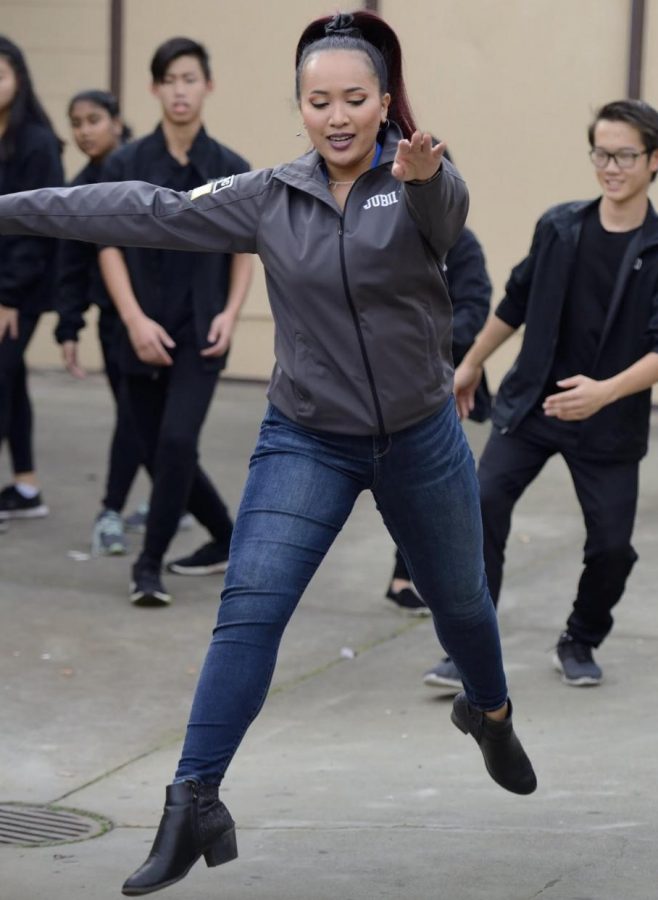Color Guard modifies its practices
The team creates a new plan to continue practicing despite quarantine restrictions
Photo used with permission from Jubilee Hardwick.
Assistant Color Guard Director Jubilee Hardwick demonstrates a move to her students during practice.
October 11, 2020
As the bus full of Color Guard members returned from the Fairfield Tournament of the Champions competition in November 2019, the atmosphere was full of music and cheer. Despite it being midnight, adrenaline was pumping among the team after winning first place in its division. Throughout her time being a Color Guard team member, junior Ariane Chen cites this as one of her most memorable moments.
Prior to remote learning, the team met four days a week from Mondays to Thursdays, as well as for football game days and on Saturdays for six hours. With remote learning, the team has changed practices to just Tuesdays and Thursdays. With shorter practices and online learning, Assistant Color Guard Director Jubilee Hardwick believes it is much harder for her to coach.
“Quarantine has definitely changed [practices] and we had to shift from having in person rehearsals to total virtual and definitely had a big learning curve using that with Color Guard,” Hardwick said. “[For example,] let’s say if I raise my right hand it looks like it’s my left hand, so we had to figure out how we are going to mirror that — we figured it out now but it took a while. We are trying to find ways to keep the students engaged — you just have space constraints at home [and] everybody has a different environment they can work in.”
As a result of remote learning, the functionality and member recruitment for Color Guard, like many other MVHS sports, has been impacted. In early May, the team’s two coaches created a plan to allow practices to continue; however, new recruitment remained an issue.
Chen points out that last year, Color Guard had around 40 members. This fall season, they’re down to 23 members.

“When you’re in person, it’s a lot easier to be closer with, because you get to talk before practice [or] during the breaks,” Chen said. “But now when there’s a break [during practice] you kind of just go off on your own and drink water by yourself. I don’t know [if we are] less tight as a team because we [still] talk over the group Messenger [chat] but for some people it can feel like there’s not as much interaction.”
In an attempt to strengthen team bonding, the leadership officers and coaches designated special meeting times where members play in online games to engage everyone, such as the popular online game skribbl.io. However, freshman Ankita Krishnan to enhance team bonding the team should be engaging in other activities so more connections can develop. Because of the lack of engagement among team members, Krishnan believes that her physical performance in Color Guard has been affected.
“I feel like I’m not able to do some of the movements in quarantine,” Krishnan said. “Since it’s on video, some of us are not able to show [the coaches] what we’re actually doing. [For example], my camera is connected to my computer, so I’m not able to maneuver it and show what [I’m] actually doing for the movement — it [can] be a little hard to get through the movement and get it right.”
Given that quarantine has brought forth many challenges, Hardwick believes she is still able to give the students the help that they need. Hardwick has tried out different methods to maintain team engagement — she believes that Zoom’s breakout room feature has been helpful, as it allows her to give one-on-one feedback to her students. She notes the difficulty of maneuvering the new digital learning world and credits the mistakes she makes as a learning opportunity for all her students and not just individually.
“[During exercises], I notice the students when they are trying out an exercise and see if maybe a student is doing OK, [or if] they’re on the right track but [need] a few tips to help them improve,” Hardwich said. “[If it] is something that the whole group can benefit from, I address that correction in front of the whole group so everybody can feed off of that and apply it to themselves.”
These new changes and difficulties are aspects of remote learning that not only Color Guard members have to deal with, but all student athletes. Regardless, Chen believes that athletes should continue to try their best to adapt to this new normal.
“I think athletes can track ways to keep motivation and [they should] remember that this won’t last forever,” Chen said. “Eventually you might be able to go back, [so] keep on practicing the stuff that you need to practice. Sometimes it might feel like ‘what’s the point of practicing?’ but you can still improve during this time and later on it will be worth it.”


















